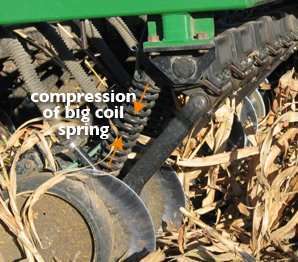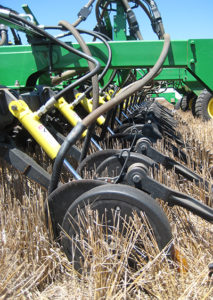Inconsistent seed placement is a primary reason why many soybean producers have to up their seeding rate as much as 20%, compared to a planter, to achieve the same desired stand count. Individual row down pressure and seed placement is still determined primarily by the coil spring on the JD drill row unit. Regardless of if it’s a 35-year-old JD 750 box drill or a brand-new JD 60’ 5 section N series cart drill, when individual rows need to drop down even just 1 inch for an old sprayer or grain cart track, the coil spring relaxes, and seed placement is compromised. Rarely, if ever, will the opener spring adjust itself quickly enough to result in adequate pressure for a leftover wheel track. In No-till this can be a big deal. Even if soil compaction has been mitigated by cover crops, divots in the fields and old sprayer tracks can cause fits for these drills.
The stretched frame, on the JD design, with carrier wheels on the front and back, create another challenge for seed placement when seeding across terraces. When crossing terraces at an angle, the stretched frame will actually hold the openers out of the ground, leaving seed on top of the ground that, many times, results in triangle shaped “bald spots”. Admit it, you know what I’m talking about if you have ever seeded a terraced field with one of these drills. I know of a custom seeding business in Kansas that seeds across the terraces and then drills out each terrace with the contour to ensure there are no skips or “bald spots” on the terraces. Admirable, but costly (who wants to pay for 20-30% more seeding inputs?). Extra time, seed, fertilizer and fuel are wasted to cover up a problem that can be rectified with UniForce.
A Nebraska UniForce customer reported, “I knew something was different the first day I went to the field with UniForce. The blackbirds where not out, picking up seed from the terrace channels!”
We have real farm size field trials proving up to 2.3 bushel increase with UniForce in soybeans. Even if you only see a one-bushel increase, hydraulic down-pressure pays its way quickly. With today’s new crop soybean prices in the teens, what are you doing to ensure the best yield possible?


